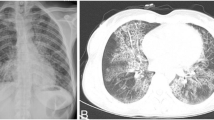Abstract
Background. Enterobacter sakazakii is a rare but important cause of life-threatening neonatal sepsis and meningitis complicated by the development of brain abscess.¶Objective. Given the neurotropic qualities of this organism, early diagnosis and treatment are crucial as a poor prognosis follows brain abscess formation.¶Materials and methods. Cross-sectional imaging (CT and MRI) play an important role in the diagnostic work-up.¶Conclusion. A biopsy-proven case of E. sakazakii brain abscess, which was diagnosed on MR images, is presented, and the importance of prompt radiologic imaging of the central nervous system in the work-up of patients with this life-threatening disease is discussed.
Similar content being viewed by others
Author information
Authors and Affiliations
Additional information
Received: 14 May 1999/Accepted: 28 July 1999
Rights and permissions
About this article
Cite this article
Burdette, J., Santos, C. Enterobacter sakazakii brain abscess in the neonate: the importance of neuroradiologic imaging. Pediatric Radiology 30, 33–34 (2000). https://doi.org/10.1007/s002470050009
Issue Date:
DOI: https://doi.org/10.1007/s002470050009




